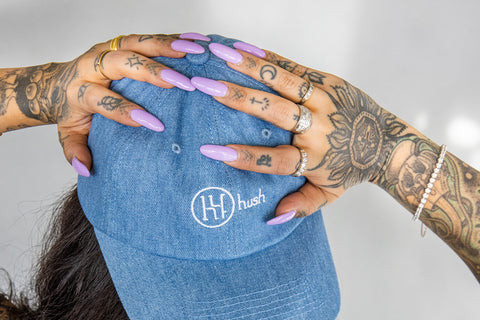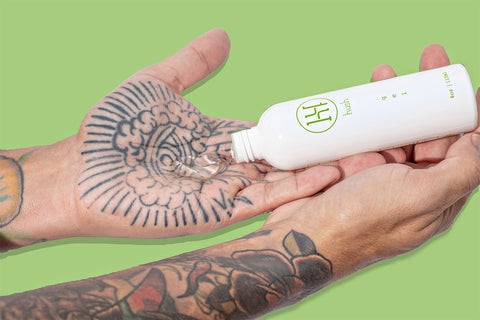Are you wondering how bad a hand tattoo is? Hand tattoos, a popular form of body art, can range from finger accents to elaborate designs on the back of the hand, and tattooat.com is here to guide you. Understanding the pain levels, design options, and proper aftercare is key to a satisfying tattoo experience, ensuring your chosen design remains vibrant and meaningful. Delve into our guide for insights on hand tattoo pain management and creative inspiration.
1. Understanding the Pain Factor: How Much Do Hand Tattoos Hurt?
Yes, hand tattoos can hurt because this area has many nerve endings, bones close to the skin’s surface, and minimal fat. However, the level of discomfort can be managed effectively with proper preparation and pain management strategies. Let’s examine why hand tattoos are considered more painful than tattoos on fleshy areas like the thigh or bicep and explore methods to mitigate pain.
1.1. Why Are Hand Tattoos Considered More Painful Than Others?
Hand tattoos are more painful due to the high concentration of nerve endings, thin skin, and lack of substantial fat. According to a study in Dermatology Research and Practice, areas with more nerve endings and less fat tend to be more sensitive during tattooing. However, perceived pain varies from person to person.
1.2. Back of Hand Tattoos: What to Expect
Tattoos on the back of your hand can be particularly painful due to the bones and tendons close to the surface. Using a topical anesthetic is advisable. As per the Journal of Pain Research, numbing creams containing lidocaine can significantly reduce pain during the tattooing process.
 Hand Tattoo Back
Hand Tattoo Back
1.3. Palm Tattoos: The Sensitivity Factor
The palm of your hand is highly sensitive, making palm tattoos potentially excruciating. The skin on your hand is almost four times more sensitive than other areas of the body. Furthermore, frequent use of your hands can cause palm tattoos to fade faster, necessitating touch-ups that can also be painful.
1.4. Finger Tattoos: Small but Intense
Finger tattoos are increasingly popular but can be quite painful. Fingers have thin skin, many nerve endings, and are quite bony. Like palm tattoos, finger tattoos might require frequent touch-ups due to constant use.
1.5. Wrist Tattoos: Navigating the Nerves
Wrist tattoos, especially on the inside of the wrist, can be quite painful due to the median nerve. The outside of the wrist is also painful because of the bones close to the surface. Healthline notes that the wrist is generally considered high on the tattoo pain chart.
2. Creative Canvas: Hand Tattoo Ideas and Inspiration
Hand tattoos range from simple to complex, constrained by the hand’s surface area. While simplicity is often key, even minimalist designs can be striking. Some people extend hand tattoos into full sleeves. Tattooat.com offers a gallery of designs. Your choice should reflect personal meaning or aesthetic preference.
2.1. The Artist’s Insight
First-timers might find tattoo shops advising against hand tattoos. This caution stems from ensuring clients don’t regret a visible, permanent decision. Experienced tattoo recipients or those with existing sleeves will likely find artists more receptive.
2.2. Hidden Finger Tattoos: Subtlety at Its Best
Hidden finger tattoos offer a discreet option, easily concealed or revealed. Black ink is common, but lighter or white ink enhances subtlety. Popular designs include lines like pens, pencils, feathers, or practical elements like measurement markings.
2.3. Ring Tattoos: A Band of Ink
Ring-shaped tattoos encircling the finger are a meaningful choice. Designs range from tribal patterns reflecting heritage to floral motifs like daisy chains or roses, symbolizing commitment.
2.4. Geometric Hand Tattoos: Inspired by Henna
Geometric patterns, particularly mandala designs inspired by henna, are popular for palm tattoos. While visually appealing, artists may caution against overly detailed designs due to potential bleeding and fading.
2.5. Small Hand Tattoos: Minimalist Statements
Small hand tattoos offer an entry point into hand tattooing. Despite their size, these tattoos can be impactful.
Here are a few ideas for small hand tattoos:
| Design | Description |
|---|---|
| Stars or moon | Celestial symbols offering mystery. |
| Rose | Timeless symbol of love and beauty. |
| Skull | Represents mortality. |
| Heart | Classic symbol of love. |
| Butterfly | Symbolizes transformation and beauty. |
| Zodiac symbol | Represents astrological sign. |
 Hand Tattoo Idea
Hand Tattoo Idea
3. Prepping for the Pain: How to Prepare For a Hand Tattoo
Proper preparation can significantly ease the pain and discomfort of a hand tattoo. Tattooat.com provides the products for your tattoo session. Preparing your hand involves several steps to ensure the skin is ready and the tattooing process is as smooth as possible.
3.1. Skincare Essentials
Begin by cleaning and shaving the hand to prepare it for the tattoo. Start with hair removal if there’s any on the back of your hand, and be gentle to prevent razor burn. Most tattoo artists will handle this in the shop if needed.
3.2. Cleansing Protocols
After shaving, thoroughly clean your hand with a product like HUSH CBD Foam Soap to ensure it is free of any dirt or oils. The hands touch many things daily, so keeping them clean is essential to prevent bacteria from entering the tattoo site.
4. Navigating the Tattoo Session: What Can I Expect During a Hand Tattoo?
During a hand tattoo session, communication with your artist is critical to manage comfort and ensure the tattoo’s quality. Your tattoo artist will guide you through the process, advising on minimizing hand movement despite potential nerve twitches.
4.1. The Importance of Staying Still
The artist will likely emphasize the importance of keeping your hand still, which can be challenging due to nerve sensitivity. Using a numbing agent can significantly help in keeping still, allowing the artist to work more efficiently and accurately.
4.2. Taking Breaks
Your artist might suggest breaks during the session. If you need a break, communicate this to your artist. Taking a moment to hydrate and rest can be beneficial, though the pain will likely resume upon restarting.
4.3. Numbing Agents
Topical anesthetics are crucial for managing pain during hand tattoos. Products like HUSH Numbing Gel and Numbing Cream contain lidocaine, which blocks pain signals to the brain. According to the National Institutes of Health, lidocaine is safe and effective for reducing pain in dermatological procedures.
5. Healing Hands: Hand Tattoo Aftercare
Proper aftercare is critical to prevent infection and ensure the tattoo heals well. Given the constant use of hands, this area requires diligent care following the tattooing session. Always follow tattoo aftercare to keep your hand tattoo safe and protected.
5.1. Hygiene Practices
Preventing bacterial contamination is critical for new hand tattoos. Consider wearing gloves for activities like cooking or cleaning to protect your healing tattoo. Washing your hands frequently with a gentle, tattoo-specific soap is crucial.
5.2. Managing Itchiness
Itchiness is common during the healing phase, but scratching can damage the tattoo and introduce bacteria. Resist the urge to scratch by using a product like HUSH Healing Spray, which soothes discomfort and promotes healing.
5.3. Moisturizing
Apply a healing balm, such as HUSH CBD Healing Balm, to keep the skin moisturized and support the healing process. Regular application of balm can also enhance the vibrancy of existing tattoos.
5.4. Sun Protection
Protect your new tattoo from the sun by wearing fingerless gloves or mittens. Once healed, apply sunscreen daily to prevent fading and maintain vibrancy.
 Hand Tattoo Aftercare
Hand Tattoo Aftercare
6. Final Thoughts: Is a Hand Tattoo Right for You?
Hand tattoos are visible, so consider what you want to convey. Also, the timing of your tattoo matters. Sunlight during healing requires protection, so plan accordingly. Despite challenges, hand tattoos can be a worthwhile expression with the right preparation and aftercare.
Hand tattoos offer a bold statement of personal expression. By understanding the potential pain, committing to proper preparation and aftercare, and choosing a design that resonates with you, your hand tattoo can be a source of lasting satisfaction.
7. Discover Your Next Hand Tattoo at Tattooat.com
Ready to explore the world of hand tattoos? Visit tattooat.com for inspiration, artist connections, and essential aftercare advice.
7.1. A Diverse Gallery of Designs
Find a design that speaks to you in tattooat.com’s extensive collection.
7.2. Connect with Talented Artists
Find the right artist for your vision in tattooat.com’s network of skilled tattoo professionals.
7.3. Expert Advice and Products
Equip yourself with the knowledge and products for a smooth tattoo experience at tattooat.com.
Contact us at:
- Address: 1825 SW Broadway, Portland, OR 97201, United States
- Phone: +1 (503) 725-3000
- Website: tattooat.com
8. FAQs About Hand Tattoos
8.1. How painful are hand tattoos compared to other areas?
Hand tattoos are generally more painful than tattoos on areas with more fat and fewer nerve endings. Areas like the thigh or upper arm tend to be less sensitive.
8.2. What are the most painful spots on the hand to get tattooed?
The most painful spots on the hand include the palm, the back of the hand (due to bones and tendons), and the wrist (due to nerves and bones). Fingers are also sensitive due to thin skin and nerve endings.
8.3. Can I use numbing cream for a hand tattoo?
Yes, using a topical anesthetic like HUSH Numbing Cream or Numbing Gel can significantly reduce pain during a hand tattoo session. These products contain lidocaine, which blocks pain signals.
8.4. How do I prepare my hand for a tattoo?
Prepare your hand by shaving the area (if necessary) and cleaning it thoroughly with antibacterial soap. Ensure your skin is free from cuts or irritation before the session.
8.5. What should I do during the tattoo session to manage pain?
During the session, try to stay relaxed and breathe deeply. Communicate with your artist about any discomfort and don’t hesitate to ask for breaks.
8.6. How long does a hand tattoo take to heal?
Hand tattoos typically take about 2 to 4 weeks to heal, but this can vary depending on individual healing rates and how well you follow aftercare instructions.
8.7. How do I care for my hand tattoo during the healing process?
Care for your hand tattoo by keeping it clean, washing it gently with tattoo-specific soap, applying a healing balm, and protecting it from the sun. Avoid scratching or picking at the tattoo.
8.8. What are the signs of infection in a hand tattoo?
Signs of infection include excessive redness, swelling, pus, fever, and increased pain. If you notice any of these signs, consult a healthcare professional immediately.
8.9. How can I prevent my hand tattoo from fading?
Prevent fading by protecting your tattoo from the sun with sunscreen or gloves, keeping it moisturized, and avoiding harsh chemicals or excessive washing.
8.10. Are hand tattoos more likely to fade than tattoos on other body parts?
Yes, hand tattoos are more prone to fading due to frequent use and exposure to the elements. Regular touch-ups may be necessary to maintain their appearance.